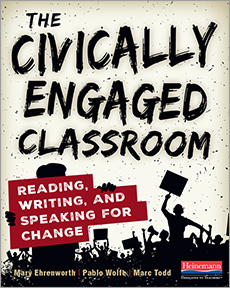Building Civically Engaged Classrooms
The Civically Engaged Classroom: Reading, Writing, and Speaking for Change
By Mary Ehrenworth, Pablo Wolfe, Marc Todd
(Heinemann, 2020 – Learn more)
Reviewed by Megan Kelly
 Is it necessary to fully disclose that one of the authors of The Civically Engaged Classroom, Mary Ehrenworth, is one of my teaching heroes?
Is it necessary to fully disclose that one of the authors of The Civically Engaged Classroom, Mary Ehrenworth, is one of my teaching heroes?
I’ve attended several institutes at Teachers College Reading Writing Project, where Ehrenworth is the Senior Deputy Director, and I always flock to her sessions for her inspirational advice.
I am thrilled that – thanks to this new book from Heinemann – teachers everywhere can benefit from her wisdom, along with that of her co-authors, Pablo Wolfe and Marc Todd.

A rallying cry for active citizens
I really appreciate that The Civically Engaged Classroom can be read on multiple levels: with tips and ideas that can be incorporated into class tomorrow, but also big picture thinking about rebooting the whole system.
The authors’ own words frame their purpose: “In these pages we hope to offer a rallying cry for, a guide to, and examples of, civic education that spurs teachers and students alike to be active participants in society. You can be a political being without sharing your voting record!”
While the book touches on current events in the United States, with references to the COVID-19 pandemic, police brutality, and the presidency of Donald Trump in the Introduction, the lessons presented throughout the book resonate around the world. I teach at an international school in Singapore and most of the text applies to my classroom of mixed nationalities.
At my school, we are in the midst of planning an interdisciplinary unit involving social studies, science, and English Language Arts. I quickly found myself jotting down ideas to share with my colleagues so that we can all use the tools provided by the authors.
One idea I’ll be sharing is about recursive notes, where students revisit the notes they’ve taken on a text and look for patterns, connections and how their thinking has changed as they’ve become more informed. I love the idea of students thinking critically about their own note-taking and becoming stronger researchers and annotators because of it.
Bridging English and social studies
There are many useful ideas for bridging English and social studies; teachers of both subject areas will be able to use these same techniques in their classes so that students can spend more time doing the work and less time trying to figure out the directions.
I’ll be collaborating with my team on these strategies during next year’s cross-curricular Identity unit, exploring how aspects of our identity make us sympathetic to certain historical figures and fictional characters. The authors include sample anchor charts that can apply to multiple subject areas. I am eager to get the “Asking Critical Questions As You Begin Research” chart up on my classroom wall.
Resources for teachers and families
I was truly inspired by this book to keep doing my homework – from its list of recommended texts and voices to explore – to rethinking my rubrics to include checklists that encourage a growth mindset – to involving the other adults in my students’ lives in our studies.
On the topic of family engagement, the authors suggest such ideas as “Create a card with suggested books and films that families might want to read and watch together.” “Send home a card with links to museum sites, websites, and digital articles.” “Ask parents and community members for help seeking sources in more than one language and from more than one perspective.” I would add to include a list of related picture books so that younger members of the family can be part of the conversation, too.
I read The Civically Engaged Classroom quickly, taking notes and making plans. I am ready to go back through now and process it all slowly, working with my colleagues to bring its lessons into our everyday teaching. This is a resource that will be in heavy rotation in the years to come.
Megan Kelly has been teaching internationally since 2003, recently in The Bahamas and now Singapore. She has a Master of Arts in Teaching and is passionate about literacy and learning through play. She tweets at @33megan33 and reviews tween and teen books at www.devourbooks.org. See writes our Wide Open Learning blog archived here.






























